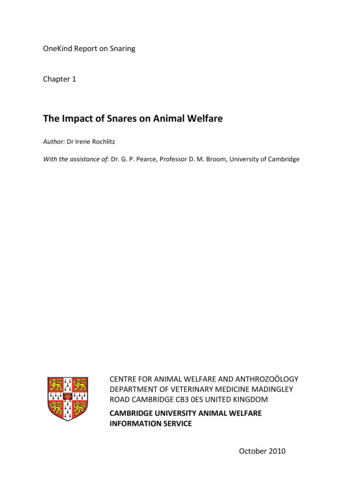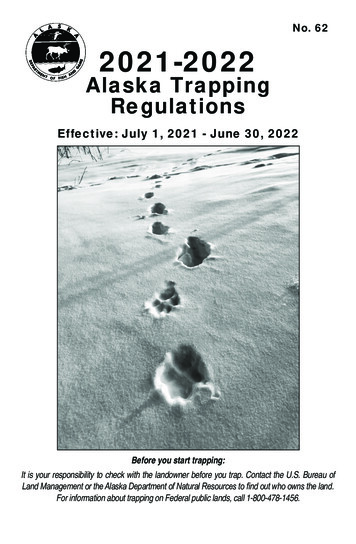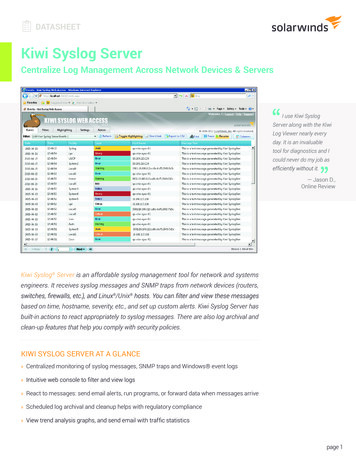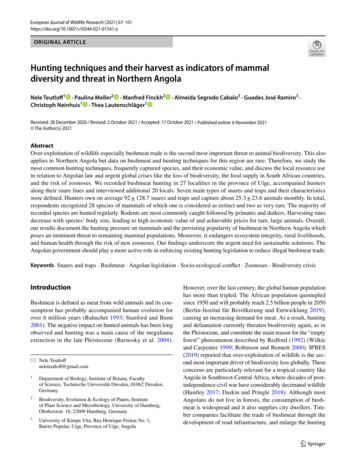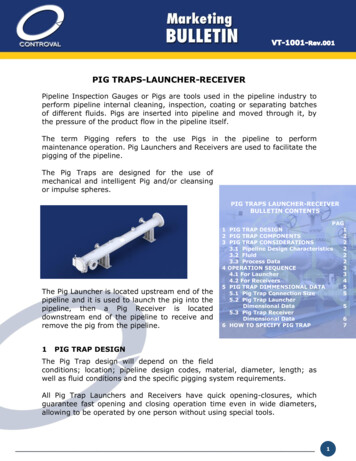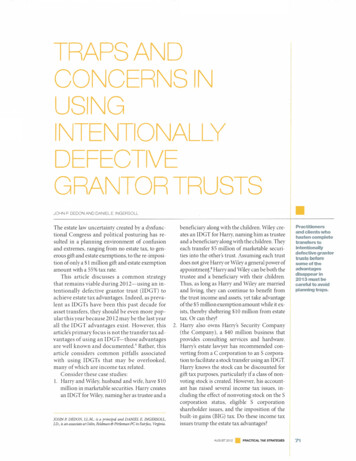
Transcription
TRAPS ANDCONCERNS INUSINGINTENTIONALLYDEFECTIVEGRANTOR TRUSTS JOHN P. DEDON AND DANIEL E. INGERSOLLThe estate law uncertainty created by a dysfunc beneficiary along with the children. Wiley cre tional Congress and political posturing has re ates an IDGT for Harry, naming him as trusteesulted in a planning environment of confusionand a beneficiary along with the children. Theyand extremes, ranging from no estate tax, to gen each transfer 5 million of marketable securi erous gift and estate exemptions, to the re-imposi ties into the other's trust. Assuming each trusttion of only a 1 million gift and estate exemptiondoes not give Harry or Wiley a general power ofamount with a 55% tax rate.appointment,2 Harry and Wiley can be both thePractitionersand clients whohasten completetransfers tointentionallydefective grantortrusts beforesome of theadvantagesdisappear inThis article discusses a common strategytrustee and a beneficiary with their children.that remains viable during 2012-using an in Thus, as long as Harry and Wiley are marriedcareful to avoidtentionally defective grantor trust (IDGT) toand living, they can continue to benefit fromplanning traps.achieve estate tax advantages. Indeed, as preva the trust income and assets, y et take advantagelent as IDGTs have been this past decade forof the 5 million exemption amount while it ex asset transfers, they should be even more pop ists, thereby sheltering 10 million from estateular this y ear because 2012 may be the last yearall the IDGT advantages exist. However, thistax. Or can they?2. Harry also owns Harry's Security Companyarticle's primary focus is not the transfer tax ad (the Company), a. 40 million business thatvantages of using an IDGT-those advantagesprovides consulting services and hardware.are well known and documented.1 Rather, thisHarry's estate lawyer has recommended con article considers common pitfalls associatedverting from a C corporation to an S corpora with using IDGTs that may be overlooked,tion to facilitate a stock transfer using an IDGT.many of which are income tax related.Consider these case studies:2013mustbeHarry knows the stock can be discounted forgift tax purposes, particularly if a class of non 1. Harry and Wiley, husband and wife, have 10voting stock is created. However, his account million in marketable securities. Harry createsant has raised several income tax issues, in an IDGT for Wiley, naming her as trustee and acluding the effect of nonvoting stock on the Scorporation status, eligible S corporationshareholder issues, and the imposition of theJOHN P DEDON, LL.M., is a principal and DANIEL E. INGERSOLL,J.D., is an associate at Odin, Feldman & Pittleman PC in Fairfax, Virginia.built-in gains (BIG) tax. Do these income taxissues trump the estate tax advantages?AUGUST2012PRACTICAL TAX STRATEGIES71
3. Harry knows that limited liability companiesother beneficiaries in a "dynasty trust" (i.e., a trust(LLCs) are useful planning tools because theylasting in perpetuity) and thereby protect thoseprovide asset protection and because nonvot assets from estate tax and creditors. The dynastying LLC interests can be transferred to enhancetrust was often created as an IDGT as describedmarket and minority discounts, similar tobelow. The assets also could be discounted to 60%transferring nonvoting stock in a corporation.or 70% of their value for transfer tax purposes.Thus, Harry can transfer as much as 99% of theThe gifts could be leveraged to allow for evenLLC equity but yet retain 100% control. In fact,greater asset transfers, through techniques thatthe office building the Company rents is heldbenefit from low interest rates.in HW LLC, which is owned 50% each byIn short, the stagnant economy, low interestHarry and Wiley. Because of these LLC ad van rates, and advantageous gift and estate tax laws,tages, Harry is considering transferring hiscombined to make 2011 a banner year forCompany stock to HW LLC, or creating a sep wealthy taxpayers doing estate planning. Willarate LLC to own the Company stock. Harry'sthis optimal estate planning environment con thought is that, if he transferred all of his Com tinue in 2012? Financial experts expect thepany stock to an LLC, he could then transfer astagnant economy and low interests rates tononvoting assignee interest in the LLC to hiscontinue. Also in place is the 5 million exemp IDGT and thereby avoid having to create non tion, which was increased by 120,000 for avoting Company stock. However, once againcost of living adjustment. The Obama adminis Harry's accountant has raised a number of is tration and Congress have targeted discountssues pertaining to the LLC and the IDGT, in on intra- family transfers and limiting dynastyeluding whether HW LLC, can own S Corpo trusts to 90 years,3 but both advantages cur ration stock, and whether Harry and Wiley canrently remain.transfer their HW LLC, 50% interests to oneuntil 2013,remaintaxes added to the tax cost of using an LLC.amount falls to 1 million. H opefully, dis whentheexemptionAfter a brief introduction to the current es-counts and unlimited dynasty trusts will re tate and gift tax state of affairs and a review ofmain too. Thus, those who wanted to act inIDGT mechanics, this article will address the2011 but failed to do so still have the opportu planning pitfalls pertaining to the fact scenar nity to transfer significant assets estate and giftios above.tax-free during 2012.42012-The end of the world as we know itWhy transfer assets to an IDGTIn the estate world, the dominant theme in 2011Lifetime gifts of assets, such as closely held stock,was the extraordinary asset transfer opportunitiesreal estate, or marketable securities, from parentsavailable to the wealthy. One could give 5 millionto children shift such assets to the next generation( 10 million for a married couple) to children orwhile minimizing estate taxes. For large gifts, anAkers, Blattmachr, and Boyle, "Creating Intentional GrantorThere is a possible "clawback" of gift taxes in post 2012Trusts," 44 Real Prop. Tr and Est L.J. 207 (Summer 2009),years if the exemption amount reverts to 1 million, but mostOshims and Joshins, "Protecting and Preserving Wealth Intocommentators view this as unlikely and expect Congress tothe Next Millennium," 137 Trusts. & Estates. 68 (October1998); Mulligan, "Sale to an Intentionally Defective Irrevoca ble Trust for a Balloon Note-An End Run Around Chapter14?" 32 U. of Miami Philip E. Heckerling Inst. on Est. Plan.Ch. 15 (1998); Oshins, King, and McDowell, "Sale to a De fective Trust: A Life Insurance Technique," 137 Trusts & Es tates 35 (April 1998).Section 2041(b)(1) generally defines a general power of ap eliminate the uncertainty.The following states allow trusts that continue in perpetuity:Alaska, Delaware, District of Columbia, Idaho, Illinois, Ken tucky, Maine, Maryland, Michigan, Missouri, Nebraska, Ne vada, New Hampshire, New Jersey, North Carolina, Ohio,Pennsylvania, Rhode Island, South Dakota, Tennessee,Utah, Virginia, Wisconsin, and Wyoming.pointment as "a power which is exercisable in favor of theSection 671 provides that all the trust income tax attributesdecedent [Harry or Wiley in this example], his estate, hisare taxed to the grantor, i.e., typically the creator of thecreditors, or the creditors of his estate." However, accordingto Section 2041(b)(1)(A), a power to consume, invade or ap propriate trust income, corpus or both for the decedent'sbenefit is not deemed a general power of appointment if it's"limited by an ascertainable standard relating to the health,education, support or maintenance of the decedent."Also targeted for elimination are other advantageous trans fer strategies, such as two-year GRATs, which are outsidePRACTICAL TAX STRATEGIES Trust. See discussion in Case Study 3.The provisions set forth in Sections 671-679 determinewhether a trust is taxed for income tax purposes as agrantor trust. These income tax provisions do not dovetailwith estate and gift tax provisions.These trusts are not designed for a marital deduction underSection 2523.Estate of Wall, 101 TC 300 (1993); Section 672(c).the scope of this article.72It is likely that the 5,120,000 exemption willIDGT. He mentions there may also be FICAAUGUST 2012INTENTIONALLY DEFECTIVE GRANTOR TRUSTS
outright transfer, although simple and straightfor sale of the asset would not result in any taxableward, may not be the most effective transfer tech gain to the grantor (for income tax purposes,nique. Aside from tax considerations, outrightthe grantor is considered to be selling an assetgifts may not be in the child's best interest depend to him or herself). There also is no interest in ing on age, financial acumen, and asset protectioncome reported by the grantor or interest deduc considerations.tion to the IDGT.One commqn method is a gift, or a gift andConsider this example of how Harry couldsale, of assets to an IDGT. The IDGT benefici transfer 40 million of Company's stock to anaries are often the children and future genera IDGT for Wiley, the children, and future gen tions as well as the other spouse. Because theerations and remove the value and its apprecia IDGT can be designed as a dynasty trust, estatetion from his estate.tax is avoided not only at the parents' deaths but1. Give 5 million in stock as a gift to the IDGT.also for future generations.5 IDGTs also are2. Sell 35 million in stock to the IDGT. The2012 may be thebeneficial because the trust is taxed as apromissory note is annual interest-only, 0.92%,"grantor trust:'6 As a grantor trust, there is nowith a nine-year term balloon payment. Theincome tax to the grantor on the sale of assetsannual interest payment would be 322,000to the IDGT. The trust income also is taxed to( 35 million principal times 0.92% AFR inter the grantor, thereby resulting indirectly in3. If the dividend on the 40 million of stock isTransfers to such a trust are said to be "effective"7% each year, the IDGT income would be 2.8come tax purposes.7 This inconsistency be advantages exist.est rate).greater tax-free gifts to the trust beneficiaries.for estate tax purposes, but "defective" for in last year all the IDGTmillion.4. After the payment of interest, the balance of thetween the estate and income tax provisions cre IDGT income may be accumulated and rein ates the planning opportunities noted above.vested by the IDGT, used to pay down princi pal, or disbursed to the IDGT beneficiaries.How to transfer assets to an IDGTAssets can be transferred to an IDGT by (1) a giftCaseStudy1or by (2) a part gift and part sale. If the assetsIn the first scenario, Harry and Wiley each createdtransferredlessan IDGT naming the other as trustee, and as a( 10,240,000 for a husband and wife) and thebeneficiary along with the children. They eachare 5,120,000millionortransferor has his or her full exemption available,transferred 5 million in marketable securities toa simple gift can be made to the IDGT. However,the IDGT they each created. Because each IDGToften the assets are both given as gifts and sold towill continue in perpetuity, the assets will avoidthe IDGT to leverage the amount of assets that canestate tax and be protected from divorce or lawsuitbe transferred, preserve the exemption amount, orfor the children and future generations. But afterdesigning the trust provisions, did they fail to con retain income.In a gift and sale scenario, the gift acts as thesider various tax and nontax issues?down payment, analogous to a down paymentFirst, what happ ens if Harry and Wiley di in a third party sale. As a rule of thumb, thevorce? If Harry transfer,red separate property tovalue of this "seed" gift should be at least 10% ofthe IDGT for Wiley, he would no longer ownthe value of all assets transferred to the trust,the property. In contrast, if the assets were ac including assets transferred by both gift andcumulated during marriage, the funding of thesale. When the gift is made, the transferortwo IDGTs would simply be a pre-funding ofwould use his or her lifetime gift exemption tothe asset division that otherwise would occuravoid paying gift taxes.in a divorce. The IDGT could define theNext, the transferor sells assets to the IDGT,"spouse" as not specifically Harry and Wiley,such as company stock, LLC interests, or realbut as "the person the Grantor is married to andestate, in exchange for an installment note. Theliving with" at the time a distribution is re note would bear interest at the applicable fed quired.8 Harry and Wiley also could each re eralrate(AFR)requiredunderSe ctionserve the right to remove the other as the1274(d). This rate is set for the life of the loan.trustee provided they appointed an independ The incredibly low AFR rate for a nine-yearent trustee.9 Harry and Wiley could also grantnote for July 2012 is 0.92%. Because the IDGTto a third party that they totally trust a limitedis a grantor trust for income tax purposes, thepower of appointment (see footnote 2) to redi-INTENTIONALLY DEFECTIVE GRANTOR TRUSTSAUGUST 2012 PRACTICAL TAX STRATEGIES73
rect the assets, including back to Harry andHarry would have a limited power of appoint Wiley. (This could present a problem underment.11Section2036 as a transfer with a retained inter The children would not be beneficiaries untilHarry's death.est, unless the power is exercisable only follow ing divorce.)Income would be paid to Harry automaticallySecond, what happens if either Harry orwhile he is living. (Wiley would receive discre Wiley dies? For example, if Harry dies, Wileytionary payments from the trust Harry createdcan no longer access the income and principalfor her.)from the assets she transferred to the trust forHarry (During Harry's lifetime, both she andHarry would benefit from income and principalAssets can betransferred to anIDGT by a gift or by apart gift and partsale.CaseStudy2from the trust she created. Now their childrenInstead of giving marketable securities as gifts,are the only beneficiaries). The trust created byHarry intends to transfer to his IDGT his biggestHarry could purchase a life insurance policy onasset, the Company stock. The transfer will be aHarry's life to be owned by the IDGT in whichpart gift and part sale, as described in the exampleWiley is the trustee and beneficiary. The policyabove. The S corporation election is critical so thatcould be an inexpensive term policy, to cover aCompany distributions can pass to the IDGT toperiod of time, or a permanent policy. Eitherservice the debt on the sale of the stock with onlyway, the death proceeds would be estate tax free,a single tax at the shareholder level. Harry's ac provide leverage for Harry and Wiley's portfo countant has raised a number of income tax issueslio, and be available for the surviving spouse.A third issue is tax related. Because Harryregarding Harry's decision to elect S corporationand Wiley created virtually identical trusts,stock requirement;they would be left in the same economic posi and 3) BIG tax issues.tion as they would have been if they had createdVoting and nonvoting stock. Harry knows thatthe trusts naming themselves as life beneficiar an S corporation may not have more than oneies of their own trusts. Thus, the IRS wouldclass of stock.12 He intends to create nonvotingconclude that the "reciprocal trust doctrine" ap stock and then transfer nonvoting stock, repre plied, and the courts would agree.10 The resultsenting 99% of the corporation's outstandingwould be that all the assets are included inshares, which will enhance the minority discount.Harry's and Wiley's estates. Fortunately there isHe will retain the voting stock, representing I% ofa solution here as well: Each IDGT can providethe outstanding shares and control of the Com the benefits Harry and Wiley desire in substan pany.tial part, but there would be key differences: InThe law is clear that stock that differs solelythe trust created by Wiley for Harry, therein voting rights does not violate the one-class would be these differences:of-stock requirement.13 However, the S Cor-10 Estate of Grace, 395 US 316, 23 AFTR2d 69-1954 (1969).11 Estate of Levy, TCM 1983-453.12 Section 1361(b)(1)(D).13 Section 1361(c)(4)("[A] corporation shall not be treated as20 Reg. 1.1361-1(m).having more than 1 class of stock solely because there aredifferences in voting rights among the shares of commonof stock, the articles of incorporation, bylaws, state law, andany other contractual arrangements between the sharehold an interest, the ESBT itself may acquire S corporation stockor other property by purchase or in a part-gift, part-saletransaction and still be an ESBT.21Section 1361 (e). The trustee makes the ESBT election. Sec 22Section 1374(d)(7). Unfortunately, after three straight yearstion 1361(e)(3).of a reduced recognition period, the recognition period hasers are relevant.14151617been reset for ten years for tax years beginning in 2012 andSection 1361(b)(1).in subsequent years. The American Recovery and Reinvest Section 1361(c)(2)(A)(i).ment Act of 2009 modified the ten-year period for 2009 andSection 1361(c)(2)(A)(ii). There is a two-year grace period2010 only and established a seven-year recognition period.from the date of death in which the S election remains valid,ThE)n, the 2010 Small Business Act modified the BIG tax forassuming that the trust is not a QSST or an ESBT.2011 only, establishing a five-year recognition period. UnderReg. 1 .1361-1U)(6)(iii). The beneficiary of the trust mustcurrent law though, if the Company converts to an S corpo timely file the QSST election with the IRS. A timely filing isration in 2012 and then Harry sells existing assets at anywithin two months and 16 days after the trust ceases to bepoint during the next ten years, the sale of those assets isa grantor trust. The trustee is not required to consent to the8119An interest in the ESBT may not be ac quired by purchase. Although no beneficiary can purchasestock"). In determining whether there is more than one class74I) the one-class-of 2) eligible shareholder issues;status. These issues include:election.subject to the BIG tax.23Reg. 1.1361-1U).For taxpayers who use the last-in, first-out (LIFO) inventoryaccounting method, under Section 1363(d), there is poten The election needs to be made within 16 days and twotial income tax recapture upon an S conversion. It is impor months from the date the stock is transferred to the trust.tant to note but not relevant to most taxpayers.PRACTICAL TAX STRATEGIESAUGUST 2012INTENTIONALLY DEFECTIVE GRANTOR TRUSTS
Single-member LLC as shareholder in an S cor be disregarded, and instead it would be treated asCase Study 2 shows that Harry cana partnership for tax purposes. A partnership can poration.transfer his Company stock to an IDGT and retainnot own stock of anS corporation.its S corporation status. However, now Harry isIn CaseStudy 3, the initial fact scenario wasconsidering transferring the Company first tothat HW LLC, was owned jointly by Harry andHW LLC. If HW LLC was owned entirely byWiley. Are a husband and wife treated as dualHarry, this step alone would not jeopardize theSmembers, thus busting the S election, or arestatus. The IRS has held that a single-member LLCthey treated as a single member because theycan be an eligible shareholder of anS corporationas long as the LLC is completely owned by an eli are married? Perhaps in community propertystates,26 or if conducting a "qualified joint ven gibleS corporation shareholder (e.g., an individ ture;'27 a married couple would be deemed aual or a grantor trust).24 Thus, if HW LLC is en "single member:' Why take the chance, how tirely owned by Harry .,or by his IDGT, thereever? Both for liability protection and to ensurewould be noS election pr ble·ms.Harry wants to transfer partial ownership of HWthe LLC is a disregarded entity, Harry shouldcreate his own LLC and transfer the CompanyHowever, Harry wants to transferstock into the new LLC. The LLC interestonly a 99% assignee interest to the IDGT and re would then be transferred to an IDGT fortain a 1% voting interest. There is no authority onWiley. Alternatively, Harry could transfer theLLC to his IDGTpoint regarding whether anS corporation ownedstock first to Wiley (or to an LLC 100% ownedby an LLC can retain its status if the LLC membersby Wiley) and, after several weeks, or even bet ter several months,28 Wiley could transfer theare Harry and Harry's IDGT. The IRS has held thatan LLC owned both by a single person and thatstock (or LLC interest) into an IDGT for Harry.person's IDGT, is a disregarded entity for federalWiley would be the Grantor and Harry wouldincome tax purposes. Thus, if a disregarded-entitybe the Trustee and beneficiary. Harry couldLLC owned by either Harry or his IDGT can be anthen again control the Company. The planningS corporation shareholder, and if an LLC that isowned by both Harry and his IDGT is a disre could use the two trust scenario discussed inCaseStudy 1.garded entity, it is reasonable to take the positionthat HW LLC, owned by both Harry and hisCreate nonvoting interest in HW LLC.IDGT, can be an eligible S corporation share to an LLC, retain a 1% membership interestholder.25(which represents the sole voting interest), andIs HW LLC still a disregarded entity if it is ownedtransfer a 99% assignee interest to his IDGT.Although it is likely that anSDoes this avoid the need to create voting andby Harry and Wiley?corporation owned by an LLC that is owned by annonvoting stock, as in Case Study 2? Unfortu individual and his IDGT retains itsS status, whatnately, if Harry transfers only voting stock toif a second individual or entity became a memberhis newly owned LLC and retains voting rightsof the LLC? In that case, it is clear that theS elec in the LLC, he would violate Section 2036(b).tion would be busted. The LLC would no longerIncluded in Harry's estate would be the entire24 Ltr. Rul. 200816002.25 The closest authoritying stock through his 1% LLC interest, all of the stock is inis Ltr. Rul. 200102037, which is in structive but not precedent.26 Rev.27his estate.30Small Business and Work Opportunity Tax Act of 2007 (Sec 2(e)(1)).31son either (1) could vest the income or principal of the trustture involving the conduct of a trade or business, in whichin himself or herself; or (2) released, in whole or in part, a(1) its only members are a husband and wife, (2) each of thepower described in (1) and following the release, such per spouses materially participates in the trade or business, andson possessed certain interests or powers in the trust, e.g.,(3) both spouses elect to treat the business entity as disre ipation standard is met if both husband and wife are involveda Crummey withdrawal right.32in the operations of the activity on a basis that is regular,282933treatedSection 2036(b). A "controlled corporation" is a corporationof at least 20% of the total combined voting power of allclasses of stock. Because Harry can vote 100% of the vot-PRACTICAL TAX STRATEGIES AUGUST 2012Roughly 7,500 per 100,000 of income, assuming one-halfthe income is paid as salary ( 50,000) and one-half is2011); Pierre, 133 TC 24 (2009).in which the decedent has the right to vote stock consistingFICA taxes are federal payroll taxes that include Social Se curity and Medicare and are 15.3%. The employer and theemployee each contribute half the amount.continuous, and substantial.See Linton, 630 F.3d 1211, 107 AFTR2d 2011-585 (CA-9,Section 678 provides that a person other than a "donor" istreated as owning a portion of a trust to the extent such per tion 761(f)). A qualified joint venture is defined as a joint ven garded for federal income tax purposes. The material partic A grantor is any person who creates a trust, or directly or in directly makes a transfer of property to a trust (Reg. 1.671-Proc. 2002-69, 2002-2 CB 831. Community propertystates include Texas, California, and Nevada.76Whatabout Harry's idea to transfer the voting stockasanScorporationdistributionratherthan 100,000 as an LLC distribution.34Harry would file IRS Form 2553 Election by a Small BusinessCorporation and Form 8832.INTENTIONALLY DEFECTIVE GRANTOR TRUSTS
value of the Company despite the transfer of aterest to his IDGT, naming Wiley as the benefi 99% nonvoting LLC interest to the IDGT. Be ciary and trustee, along with the children.The advantages of this plan include the fol cause Harry's Company is a "controlled corpo ration:' and because Harry can vote 100% of thelowing:voting stock through his 1% LLC member in oThus, although the LLC may provide Harryotransfer is through a 99% assignee interest, itWiley is trustee and a beneficiary of the IDGTassets.with better asset protection and perhaps agreater discount of the stock value because theHarry retains control of the assets as the LLCmanaging member.terest, all of the stock would be in his estate.29oHarry can simplify the reporting because HWLLC can file as a disregarded entity.would not avoid the need to create voting andAdditionally, now the Company nonvotingnonvoting stock. Only the nonvoting stockstock could be transferred to the LLC withoutwould be owned by the LLC.Can Harry and Wiley transfer their HW LLC inter jeopardizing the S election. Harry and Wileywould either gift split or, as a separate step,est to one IDGT? Assume HW LLC will not own SWiley could use her exemption and create hercorporation stock because it may not be a disre own IDGT to transfer assets to a trust for Harrygarded entity, but only the office building. Harryand the children as in Case Study 1.and Wiley each intend to transfer a 49% assigneeWhat about FICA tax issues? If HW LLC isinterest to an IDGT. They will each retain a 1%taxed as a disregarded entity, the taxable income ismembership interest to retain 100% control.subject to the Federal Insurance ContributionsShould they create one IDGT or should they eachAct (FICA) taxes.32 On the other hand, S corpora have an IDGT?The "grantor" of an I D G T is generallytions pay FICA on W-2 wages, but not distribu tions. In order for HW LLC to avoid paying FICAsubject to i ncom e tax on the trust income.30on 100% of its income, it could elect to be taxed asThe grantor is the individual that creates thean S corporation, even if it is owned 50% each byIDGT and transfers assets to it. Ty pically,Harry and Wiley or solely by Harry and his IDGT.under S ections 673 through 679, the grantorThe income tax savings attributable to an S elec is also the owner of all the IDGT assets fortion can be significant.33 Harry should considerincome tax purposes. However, u nder S ec electing S status for the LLC34 unless the LLCtion 678, someone other than the grantorwould own nonvoting stock in the Company,may be considered the owner and subject towhich would bust the Company S election.trust income.31If one IDGT receives Harry and Wiley's 49%assignee interests through a gift and sale trans Conclusionaction, both Harry and Wiley are grantors ofThe advantages of lifetime transfers using IDGTshalf the trust. Because they are married and re that can last in perpetuity are well known. It isporting income on their joint return, therelikely that this transfer strategy will be even moreshould not be income tax on the sale portion ofprevalent over the remaining months of 2012. Bythe transaction. However, to avoid complica 2013, it is doubtful that all the transfer advantagestions, Harry and Wiley should consider eachwill survive, e.g., the 5,120,000 gift exemption,transferring their interest to their own IDGT.intra-family discounts on transferred assets, andThe following plan, however, would be evenlow interest rates. With this in mind, in their hastebetter:to complete the transfers, practitioners and their1. Wiley transfers her 50% interest in HW LLC, toclients need to avoid traps in the planning. The is Harry.2. After a reasonable time (see the cases cited infootnote 28), Harry transfers a 99% assignee in-INTENTIONALLY DEFECTIVE GRANTOR TRUSTSsues illustrated in the Case Studies set forth aboveprovide a practical way to navigate through theplanning minefields.AUGUST 2012 PRACTICAL TAX STRATEGIES
Section 671 provides that all the trust income tax attributes are taxed to the grantor, i.e., typically the creator of the Trust. See discussion in Case Study 3. The provisions set forth in Sections 671-679 determine whether a trust is taxed for income tax purposes as a grantor trust. These income tax provisions do not dovetail





